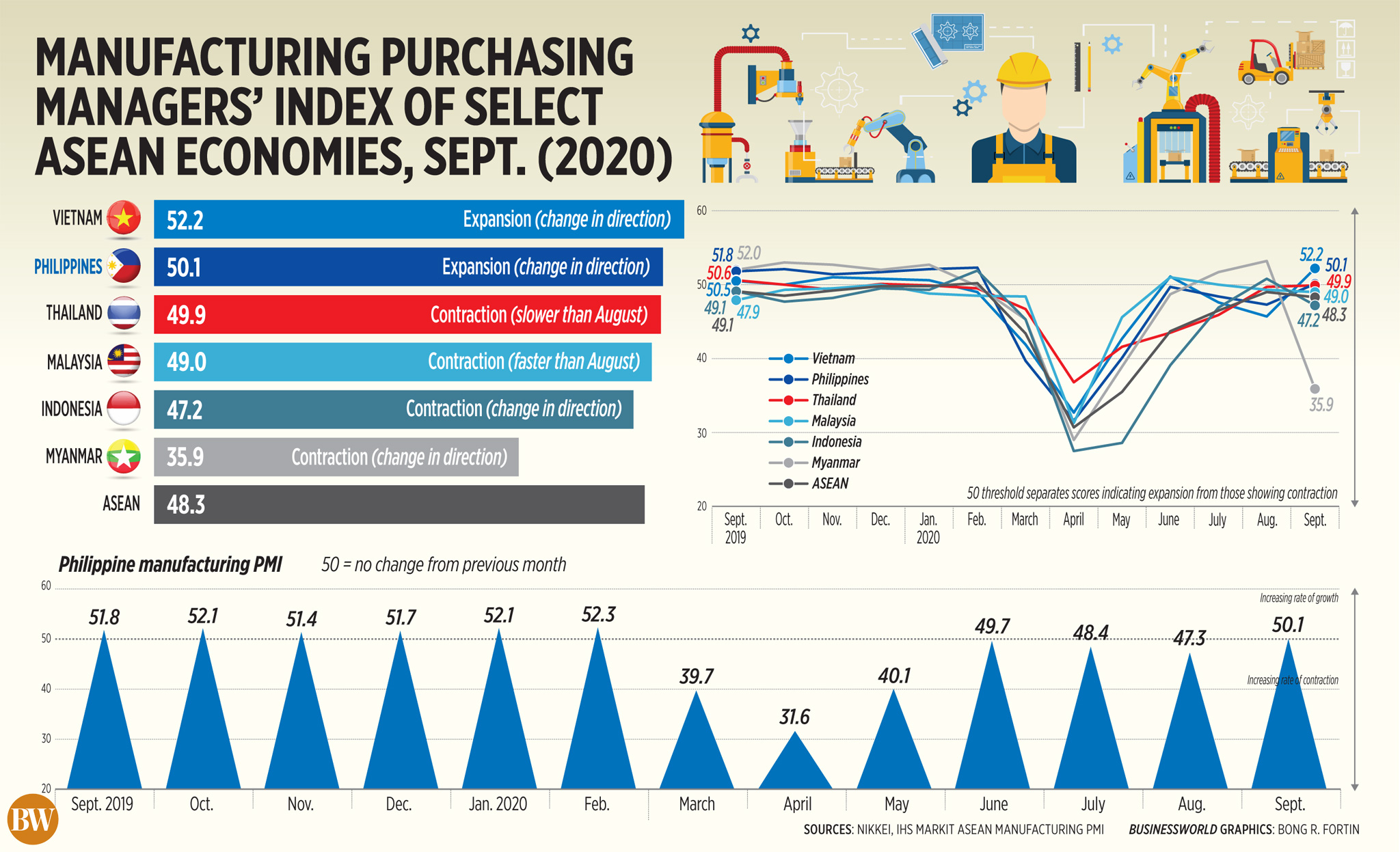
By Beatrice M. Laforga, Reporter
PHILIPPINE factory activity expanded for the first time in seven months in September as a looser lockdown helped prop up consumer spending, according to a survey by IHS Markit.
In a statement on Thursday, IHS Markit reported the country’s Manufacturing Purchasing Managers’ Index (PMI) improved to 50.2 last month from 47.3 in August. This was the first time since February that it breached the 50-neutral mark that separates expansion from contraction.
“The latest reading was the highest since February and signalled that operating conditions were broadly stable across the goods producing sector,” IHS Markit said.
Most parts of the Philippines were under the strictest form of lockdown from mid-March to May, halting nearly all economic activity. Restrictions have been eased to allow many businesses to resume operations, although health and safety protocols remain as the number of coronavirus infections still rise.
The headline PMI measures manufacturing conditions through the weighted average of five indices: new orders (30%), output (25%), employment (20%), suppliers’ delivery times (15%) and stocks of purchases (10%).
The Philippines and Vietnam were the only two Association of Southeast Asian Nations (ASEAN) member-economies that saw PMI growth last month. Vietnam’s PMI rose to 52.2, the highest in the region.
Manufacturing activity worsened for most of the region, bringing the regional average to 48.3 in September from 49 in the previous month.
For Philippine manufacturing firms, IHS Markit said overall new orders climbed for the first time in seven months but only slightly amid the further reopening of the economy and stronger demand from customers.
Export sales also improved in September after six months of consecutive contraction, after clients were reportedly stocking up in anticipation of better market conditions in the coming months.
However, factory output declined for the third straight month albeit at the slowest pace in September.
“According to firms, the ongoing restrictions related to the COVID-19 pandemic continued to limit the performance of the sector, with some businesses forced to pare back operations,” Shreeya Patel, economist at IHS Markit was quoted as saying.
Workforce numbers remained on a downtrend for the seventh straight month. This was attributed to voluntary resignation of employees and cost-cutting measures implemented by the companies.
“Another reduction in backlogs of work highlighted evidence that spare capacity persisted across the manufacturing sector,” IHS Markit said.
Manufacturing firms also saw a temporary rise in inventory last month, with stocks of raw materials and finished goods seeing a slight uptick for the first time in seven months.
However, more expensive transportation costs, material shortages and reported supplier surcharges related to the pandemic have resulted in a heavier cost burden for the respondents.
“Manufacturers had some difficulty passing on higher costs to clients due to tough market competition, however, with factory gate charges rising only marginally,” it said.
Overall, good producers were still optimistic of the output volumes in the next 12 months, while business expectations surged to its highest level since February as firms hope demand will bounce back to pre-pandemic levels.
“Stronger business sentiment and efforts to rebuild stocks suggest panellists are preparing for an improvement in demand over the coming months, although optimism continues to rest on the development of the pandemic,” Ms. Patel said.
Respondents with subdued expectations cited the ongoing income losses and uncertainties amid the coronavirus pandemic.
“The bounce in PMI manufacturing was a welcome development as it does point to some gradual recovery after the index previously declined in August. The sharp bounce, however, was traced more to higher price indices given still tight supply chains with firms unable to completely pass on increase to the consumer given poor demand conditions,” ING Bank N.V. Manila Branch Senior Economist Nicholas Antonio T. Mapa said in an e-mail.
University of Asia and the Pacific School of Economics Senior Economist Cid L. Terosa said the pickup in PMI signals that manufacturers are positioning themselves for the possible revival of economic activities.
Mr. Terosa expects the index to hover above the 50-neutral mark in the coming months amid looser lockdowns and the nearing holiday season.
“The downside risks to this would be a resurgence in the number of COVID-19 cases that would again stunt market activity and render unprofitable spiked up production. Also, greater demand for raw materials or production inputs can raise production costs and consequently prices. This should be expected, however, with greater production activity after a long lull,” he said in an e-mail.
However, Mr. Mapa said the low production volumes still reflect the dampened economic conditions. He said sustaining the rebound in new orders will depend on how the coronavirus outbreak will be contained.
“Overall, we note some green shoots of hope for a recovery but we reserve our cheers for a turnaround until we can see a sustained pace of gains that would signal that the economy is fully on the mend,” he added.

